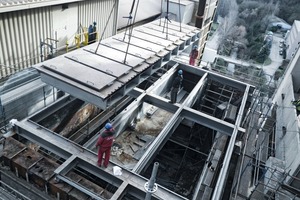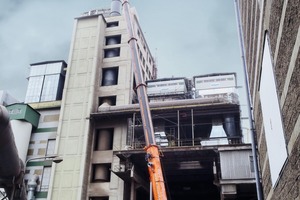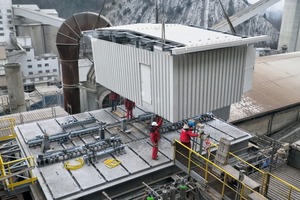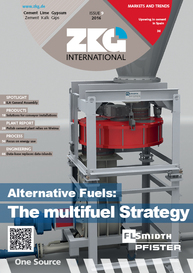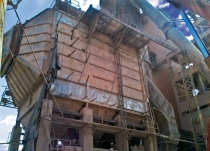Scheuch demonstrates solution expertise
HeidelbergCement, one of the world’s biggest building materials companies, produces cement in the Czech municipal district of Radotín, Prague. The electrostatic precipitators at the Ceskomoravsky cement plant had to be replaced with bag filters in order to meet environmental standards. Scheuch was commissioned with this task and was confronted with the “problem child” of this historical plant in the form of its gas towers.
“The plant near Prague is an industrial gem. However, the conversion specifications from the plant management were anything but outdated – they were extremely challenging,” reports Georg Lechner, Head of Sales for the Industrial Minerals Industry division at Scheuch. “The order involved two elements. Each of the two dust extraction units has two components: a gas conditioning tower to cool and condition the gas so that it can be cleaned in the electrostatic precipitator afterwards, and then the electrostatic precipitator itself. We were given the task of converting the electrostatic precipitators to bag filters one year after another. But the conditioning towers proved especially problematic. The inflow was very unfavourable, which led to a large amount of deposits and limited the function accordingly. To ensure that our bag filter systems could work at an optimal rate, we had to find a solution. This was the only way of guaranteeing that the required specifications and performance values were met,” says Lechner, describing the situation.
Simulating the flow of the real-life plant
To find the optimal inflow, Scheuch’s flow specialists simulated the real-life plant. A solution was found which assured the desired improvement with relatively little mechanical reconstruction work. Once the concept had been developed on the computer, it was ultimately applied to the real-life plant. At the same time, the outdated spray lances were replaced with a modern bundle-head lance system together with a new pump station, pipework and control. This enabled the plant to meet the specification to reliably reduce the furnace exhaust gas to outlet temperatures below 130 °C.
First construction stage completed successfully
In the first construction stage, both gas conditioning towers and an electrostatic precipitator had to be converted simultaneously. Only ten weeks were available for work on the electrostatic precipitator. The period of production downtime in which both gas conditioning towers had to be modernised was even shorter, with merely three weeks allotted. The tight schedule and additional behind-the-scenes “renovation work” presented the whole assembly crew with major challenges. “The team has accomplished a true masterpiece here,” Lechner enthuses. Around twelve employees were working on site. Working conditions were made even more difficult by the fact that the electrostatic precipitators had to be modified 25 m above the ground and the strong winds often restricted work.
Not only the tight time specifications, but all the parameters that had been set by the Ceskomoravsky cement plant were fulfilled, some even exceeded. The second electrostatic precipitator is currently being modified. “Scheuch’s turnkey strategy pays off when solving tricky cases. Very few manufacturers can offer everything from a single source. It is only through the cooperation of a good engineering team and an effective assembly team that we can solve such complex customer problems,” Lechner says confidently.
//www.scheuch.com" target="_blank" >www.scheuch.com:www.scheuch.com

